When I first sat down to play Monster Train from developer Shiny Shoe, I expected it would draw comparison to Mega Crit Games’ card-base rogue-like darling Slay the Spire. Following my first run, I had to double-check if Monster Train really was from a different developer. Despite coming from entirely separate studios, Slay the Spire and Monster Train share a lot of the same ingredients.

As a rogue-like, you will build your deck over the course of a run but lose it all if defeated. Each run can be a little different, with various starting relics available that confer unique bonuses for that run and different boss effects that buff your enemies. Beyond the simple fact of being the same genre, however there are mechanics that function almost identically; for example, enemies that shuffle dud cards into your deck that then take up valuable slots in a hand that’s drawn fresh each turn, or paid card removal services encountered on a branching overworld map between fights. If Monster Train were just copying, however, this wouldn’t be surprising. After all, latching onto successful ideas and recreating them is standard for most industries, and the years of brown shooters in the mid 2000’s or the current wave of battle royales prove gaming is no exception. Instead, what made Monster Train feel like the next installment from the same team rather than a spin off from another studio was how each mechanic felt expanded beyond what came before.
Where Slay the Spyre would have your hero battle against a group of monsters until you win or die each fight, Monster Train gives you a hand full of units to summon that then battle across multiple floors at once against waves of incoming enemies. Rather than fighting a series of small battles building up to a boss, Monster Train throws these battles at you simultaneously and gives you a wider variety of card types and effects to fight your way out. Slay the Spyre would occasionally let you upgrade a card to its predetermined next evolution, but Monster Train gives you options to choose specifically how cards are upgraded – whether that’s less summon cost, more power, or beneficial status effects like Quick ; an ability that allow your units to deal damage before enemy monsters, taking a unit with high power and low health from a glass cannon to an unstoppable one-shot machine.

At the beginning of each run you will choose your primary and allied clans. Your primary clan determines many of your starting cards and your champion; a powerful unit that can be upgraded throughout the run and is always drawn in your opening hand each battle. The allied clan bolsters your starting deck with its own cards but does not provide a champion. The interface shows a choice between five clans, but the beta had only the Awoken and Hellhorned available.
With your clan chosen, your train begins its journey through the nine circles of Hell. Entering each circle begins a battle, with enemies growing more powerful the further you advance. These battles play out across four floors of your train. The first three floors allow you to play units or spells, while the top floor houses your Pyre. Aside from a few special cases, enemies enter on the lowest floor and ascend one floor per round until they reach your Pyre and attack it directly. The Pyre is able to fight back, dealing damage to all attackers on its floor, but if it’s destroyed your run is over.
In each circle of Hell, the track diverges to present a choice between two paths. The route you pick will give you access to all interactables on that side of the tracks; vendors who can upgrade your cards in exchange for gold, banners that will allow you to recruit new units, and chests that contain relics can all be found on these brief treks between battles.
The most interesting of these encounters is the icy caverns, which present a random encounter that adds some flavour to the world. These encounters can be solely beneficial, such as an encounter with a chronicler who can bestow a permanent buff on your Pyre, or more mixed such as the choice to gamble the Pyre’s health for some immediate gold.

Overall, Monster Train is an engaging game in a genre that’s hard to pin down. It’s easy to compare to Slay the Spire when that’s a massively successful game in this same uncommon style, but it’s a testament to the quality of Monster Train that it can hold up to that comparison so well. Monster Train is not an imitation; it’s clear from the expanded mechanics of more detailed boss fights and the overhauled multi-floor system for battles that this wasn’t a game designed to follow in another’s shadow. The sheer style of Steampunk demons fighting an iron-winged Daedalus definitely hammers home the creative flair and originality woven through the game.
I expected Monster Train to be a fun derivative of a game I already enjoyed, but Monster Train feels more like an evolution. It’s clear that instead of imitating a trend, Monster Train is from a team that wanted to make exactly this game. Monster Train will surely eat up hours more of my time following its full release later this year.




